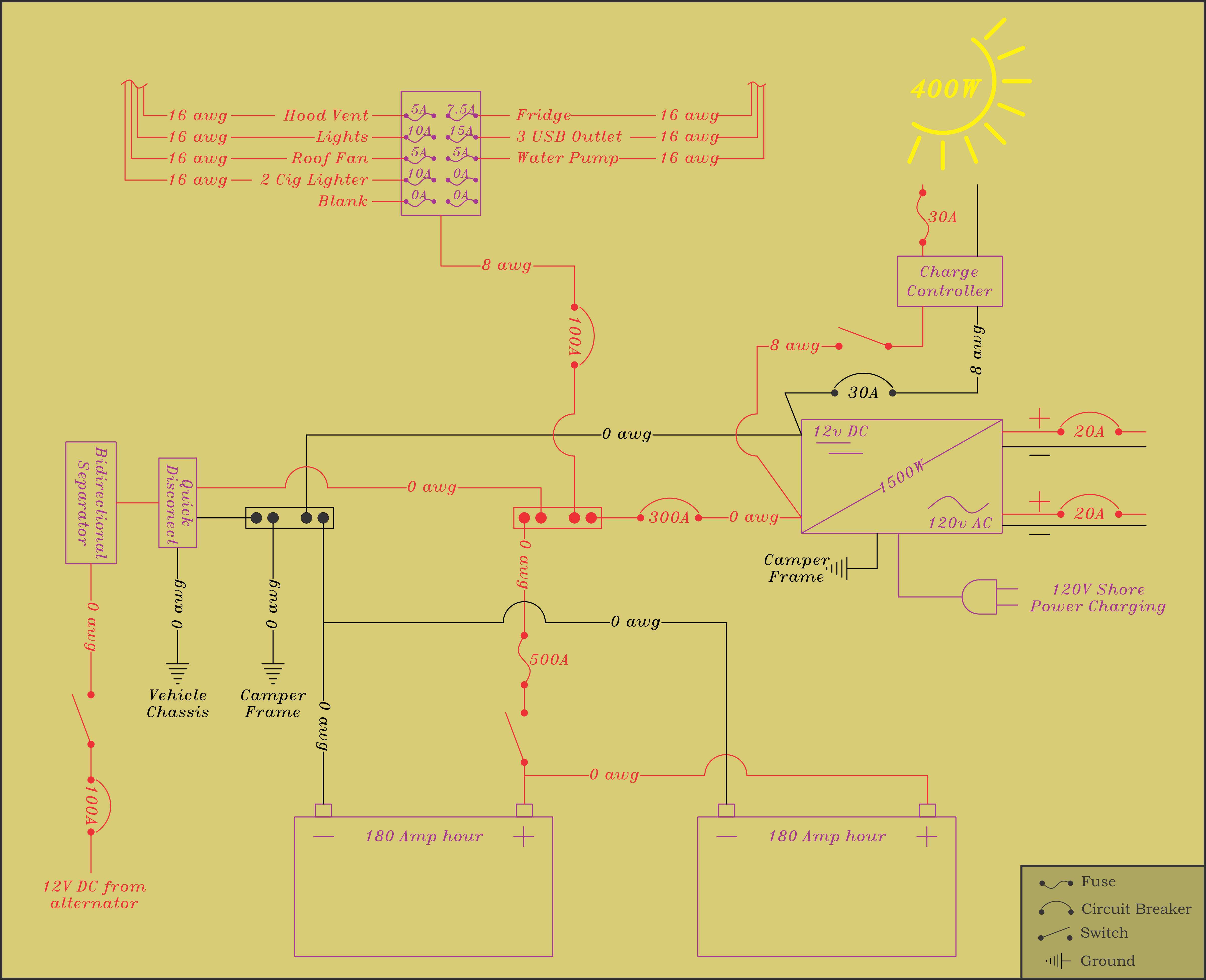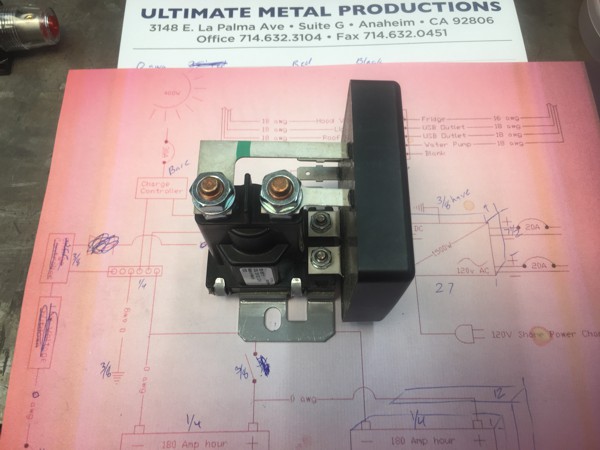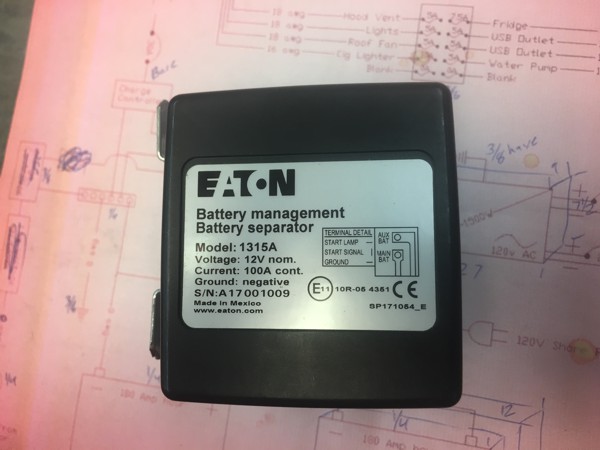No off grid system would be complete without a proper solar set up. I don’t plan on spending a lot of time at campgrounds with hook ups so I need solar to get power. I plan to make most of my money working from my lap top so I’ll need to be able to power that, charge my phone, run lights, fridge, and of course the coffee maker. But let me back up a second. I should say that I am by no means an expert on this subject. I would claim that I have an above average knowledge of how electrical systems work, however I had to consult an expert and do a lot of internet research to get to this point. I am posting this for entertainment purposes only and if you don’t already know what you are doing you should consult someone that does before attempting any of this.
My original plan was to get a Goal Zero set up but then a friend talked me out of it. Not to say anything bad about Goal Zero, we think they have the best plug and play set up around. It’s just the cost would be significantly more for a system with similar available power to the one we designed. My friend is an engineer that worked for a solar company when we first started planning this project but has since taken a job with an Aerospace company working on solar units that are going to space, so yeah, he knows a little bit.
I shouldn’t really call it a solar set up as that is just one aspect of the system. My system is centered around two 180 ah, AGM batteries that power everything and the solar is my primary method of recharging those batteries. That said I have three available methods for charging: 400W of solar, I can plug into shore power with a regular extension cord, and I will have a line run from my alternator on the truck that isn’t hooked up yet but I’ll get to it.
In order to figure out how big of a system I was going to need I calculated how much power I intended on using in a day if I ran everything that day. Then I figured out how much solar panel I would need to recharge the system. I figured that I will use up to 150 ah a day when I calculated the draw from each of the devices I will be powering; including running my lap top for up to 12 hrs. You’re not supposed to drain your batteries more than half way or it will do damage so I gave myself a 30 ah buffer and then doubled the capacity by adding a second battery. I calculated that 400watts of solar should fully charge the batteries if drained by half as long as I get 5hrs of direct sunlight. There are a couple of buffers built in but it’s also not likely that I will run everything everyday so the system should be a little overkill.
I wired the batteries in parallel to keep my system 12v (i.e. not 24v or 48v) as all of my lights and DC appliances run off of 12v. The Inverter and fridge could go to 24v and run more efficiently but they run fine off of 12v. If you are unclear of the difference between series and parallel I tried to explain it here.
Wiring the system properly took some research but it wasn’t too difficult. The basic concept is to figure the amount of amperage needed and then give it a breaker at that amperage and a wire that can handle the flow. For example my power inverter is 1500W but it can run up to 3500W for a short time if needed. 3500W/12v=291amps so I needed a 300amp breaker.
For wire size I consulted a wire chart. When calculating wire length don’t forget to add in the length of the ground wire, so if you have a 5’ positive you should also have a 5’ ground equaling 10’. Even if you ground to the frame just off the device I’d still double the positive. If for some reason your ground is longer than your positive account for that. My lead to my inverter is 10’ feet and I’m running 300amps so this means I need a 0awg wire. Running a bigger wire is fine and it will actually have less resistance but I wouldn’t ever go to a smaller wire. Too small of a wire will create resistance and that will heat up the wire and could lead to a fire. I came across several of these charts with a google search and most of them were the same but there were a few minor differences, I went with the most conservative chart.
After figuring out what size breakers/fuses and wire sizes I then started to put together a schematic that would help me keep everything straight. I tend to be a little overly cautious and I like to have a breaker or fuse near the source of anything that stores or creates power. It is important to be able to isolate anything that could kill you.
For the charge coming off the trucks alternator I had to put in a device that isolates the different battery systems. I used a Bidirectional Separator but there are other devices. The truck battery is also 12v but it is not a deep cycle, it is made to maximize cold cranking amps (i.e. a lot of power, right now, to crank the engine over) whereas the house batteries are designed to give power out more gradually. If I tried to start the truck off of the house batteries it would damage them and running my house electricity off of my truck battery could kill it. Another issue is if you connect all of the batteries together they will all charge to the weakest and cause all sorts of issues.
The Bidirectional Separator fixes these issues by prioritizing the way the power runs through the device. When I start my truck the separator will isolate the power coming from the house batteries so that it only uses the truck battery. While I’m driving the separator will charge the truck battery first then once it is fully charged it will start sending power to charge the house batteries. On the other side, when the truck is not running and the solar panels are charging the batteries it will charge the house batteries first then once they are fully charged it will start to charge the truck battery. It isolates the truck battery from any power draw from the house usage so you don’t drain it down.
You can wire a switch onto the separator so that you can start the truck off of the house batteries in an emergency if your batteries can take is but mine can’t so I’m not going to wire it that way.
A lot went into the electrical so rather than have one real long post I’ve decided to split it into several. This will make it easier on me and it will allow me to be more thorough. I will try and release one a week until I’m done, I hope you enjoy the series.






0 Comments